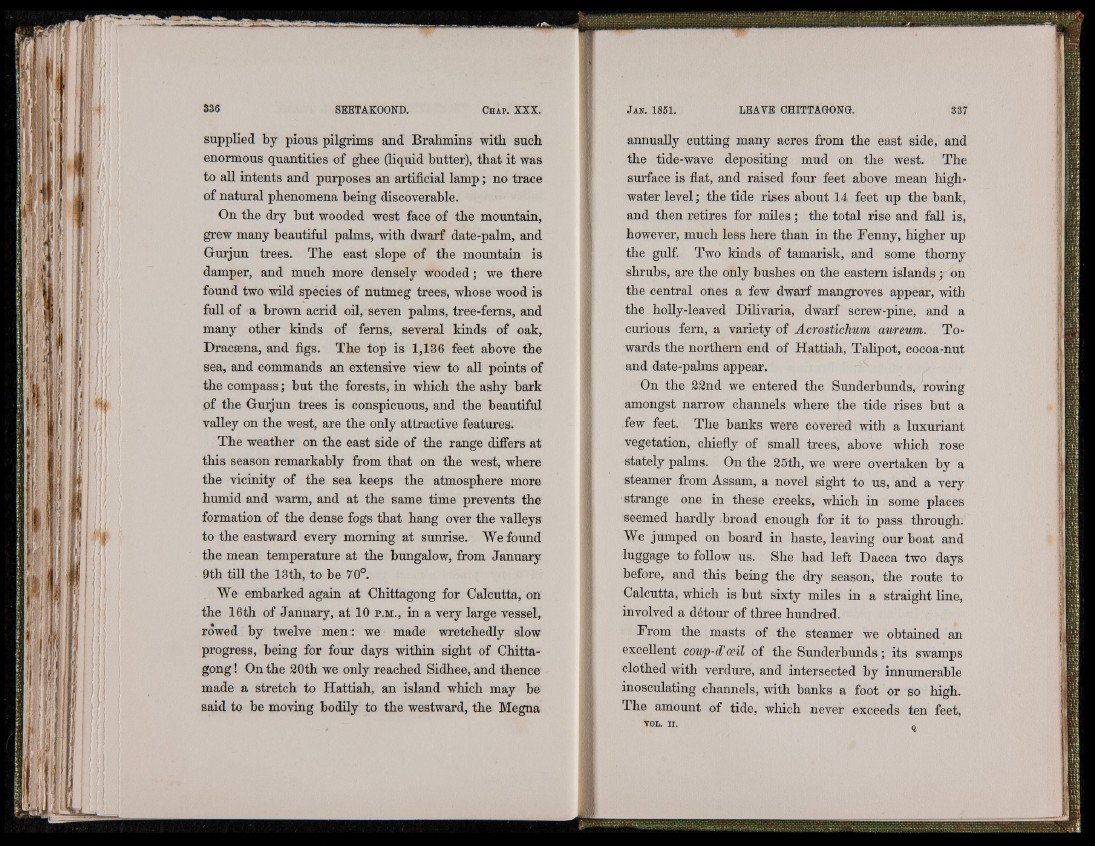
supplied by pious pilgrims and Brahmins with such
enormous quantities of ghee (liquid butter), that it was
to all intents and purposes an artificial lamp; no trace
of natural phenomena being discoverable.
On the dry but wooded west face of the mountain,
grew many beautiful palms, with dwarf date-palm, and
Gurjun trees. The east slope of the mountain is
damper, and much more densely wooded; we there
found two wild species of nutmeg trees, whose wood is
full of a brown acrid oil, seven palms, tree-ferns, and
many other kinds of ferns, several kinds of oak,
Dracaena, and figs. The top is 1,136 feet above the
sea, and commands an extensive view to all points of
the compass; but the forests, in which the ashy bark
pf the Gurjun trees is conspicuous, and the beautiful
valley on the west, are the only attractive features.
The weather on the east side of the range differs at
this season remarkably from that on the west, where
the vicinity of the sea keeps the atmosphere more
humid and warm, and at the same time prevents the
formation of the dense fogs that hang over the valleys
to the eastward every morning at sunrise. We found
the mean temperature at the bungalow, from January
9th till the 13th, to be 70°.
We embarked again at Chittagong for Calcutta, on
the 16th of January, at 10 p .m ., in a very large vessel,
rowed by twelve men:: we made wretchedly slow
progress, being for four days within sight of Chittagong
! On the 20th we only reached Sidhee, and thence
made a stretch to Hattiah, an island which may be
said to be moving bodily to the westward, the Megna
annually cutting many acres from the east side, and
the tide-wave depositing mud on the west. The
surface is flat, and raised four feet above mean high-
water level ; the tide rises about 14 feet up the bank,
and then retires for miles ; the total rise and fall is,
however, much less here than in the Fenny, higher up
the gulf. Two kinds of tamarisk, and some thorny
shrubs, are the only bushes on the eastern islands ^ on
the central ones a few dwarf mangroves appear, with
the holly-leaved Dilivaria, dwarf screw-pine, and a
curious fern, a variety of Acrostichwn awrewm. Towards
the northern end of Hattiah, Talipot, cocoa-nut
and date-palms appear.
On the 22nd we entered the Sunderbunds, rowing
amongst narrow channels where the tide rises but a
few feet. The banks were covered with a luxuriant
vegetation, chiefly of small trees, above which rose
stately palms. On the 25th, we were overtaken by a
steamer from Assam, a novel sight to us, and a very
strange one in these creeks, which in some places
seemed hardly broad enough for it to pass through.
We jumped on board in haste, leaving our boat and
luggage to follow us. She had left Dacca two days
before, and this being the dry season, the route to
Calcutta, which is but sixty miles in a straight line,
involved a détour of three hundred.
From the masts of the steamer we obtained an
excellent coup-d'ceil of the Sunderbunds ; its swamps
clothed with verdure, and intersected by innumerable
inosculating channels, with banks a foot or so high.
The amount of tide, which never exceeds ten feet,